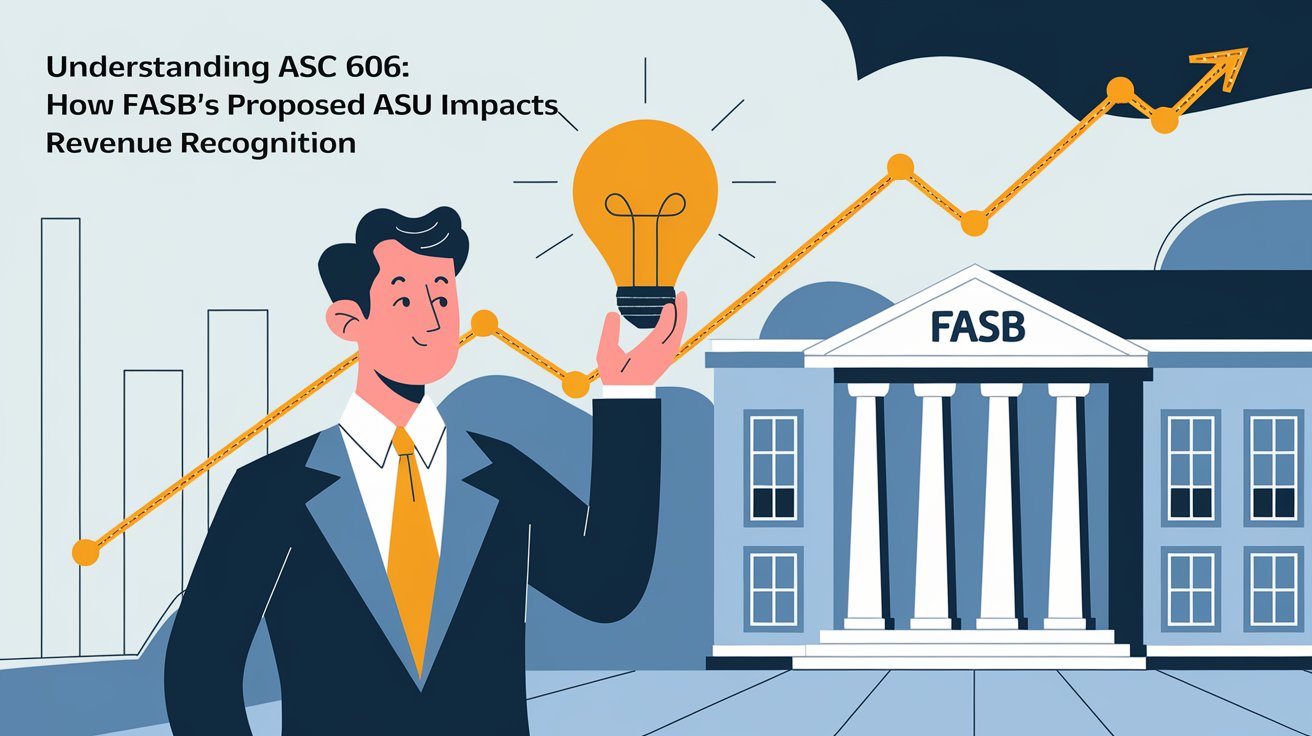Understanding ASC 606: How FASB’s Proposed ASU Impacts Revenue Recognition

Did you know? According to industry insights, businesses faced significant challenges when adapting to ASC 606. However, those who successfully adapted reported improved accuracy and financial clarity.
Accounting standards are constantly changing, and keeping up with them can feel overwhelming. One of the most talked-about standards today is ASC 606. It is designed to bring consistency and clarity to the revenue recognition. It is better for businesses to change their financial reporting approach because of the FASB’s proposed Accounting Standards Update (ASU).
What Is ASC 606?
ASC 606 is an accounting standard that was made to recognize business revenue. It was developed by the Financial Accounting Standards Board (FASB) and the International Accounting Standards Board (IASB). According to FASB’s Post Implementation Review of ASC 606, it made financial reports transparent and easy to compare across all industries. This makes it important for both businesses and their stakeholders.
Key Principles of ASC 606
ASC is based on these principles:
- Revenue is recognized as performance obligations are met.
- Companies follow a five-step model to figure out and record revenue.
What Is the Five-Step Model?
Here is the five-step model that helps businesses understand the contract process.
- Identify the contract: What did the company agree to do for the customer?
- Identify the performance obligations: What specific goods or services is the company providing?
- Determine the transaction price: How much is the customer paying?
- Allocate the price: Divide the payment among the performance obligations.
- Recognize revenue: Record revenue when each obligation is completed.
A detailed understanding of the Five-Step Model is crucial to businesses for the contract process.
Why Does It Matter?
ASC 606 helps businesses by providing transparent and consistent ways of recording revenue. Before, different industry businesses had their unique ways of recognizing revenue. ASC 606 solves this problem by providing a single standard for all. It is important for everyone who relies on a business’s financial statements, like investors, customers, and regulators. It helps them build trust in the business.
Applying ASC 606 boosts the trust of your business in the industry and sets a strong foundation for future growth.
What Is the Proposed ASU?
The Proposed ASU (Codification Improvements) released by FASB is part of an ongoing project to refine ASC topics based on stakeholder feedback. It introduces incremental adjustments across various accounting topics, including those affecting ASC 606.
The amendments are designed to improve clarity without significantly changing current accounting practices. They address technical corrections, unintended applications of the codification, and other minor improvements. The proposed updates also aim to ensure consistency in revenue recognition and provide clearer guidance for entities operating in complex financial environments.
Key Updates Affecting ASC 606
The following are the key updates affecting ASC 606:
1) Clarification on the Transfer of Receivables
- The update clarifies how entities should account for the transfer of receivables from contracts with customers.
- Per ASC 606-10-45-4, receivables represent an unconditional right to payment, typically recognized before goods or services are transferred.
- The amendment specifies that such receivables are financial assets and should be evaluated under Subtopic 860-10: Transfers and Servicing—Overall, aligning the treatment of these receivables with broader financial asset transfer guidance.
2) Impact on Not-for-Profit Entities (NFPs)
- The update includes amendments for credit loss measurement of receivables arising from exchange transactions.
- This change ensures that all entities, including NFPs, measure such receivables using consistent credit loss guidance.
- The update also introduces a practical expedient and policy election for private companies and certain NFPs to simplify the application of credit loss guidance for receivables tied to contracts governed by ASC 606.
3) Refinements in Comprehensive Income Reporting
- The proposed ASU corrects errors and clarifies the presentation of comprehensive income. For example, it updates the terminology in illustrations of “Other Comprehensive Income” to ensure consistency across financial statements.
Why Are These Changes Important?
The FASB’s latest updates are vital for several reasons:
Improved Financial Reporting
The clarifications address existing ambiguities. This helps entities streamline their accounting practices and comply with ASC 606 requirements more effectively.
Consistency Across Entities
By aligning credit loss guidance and treatment of receivables, the update ensures that public, private, and nonprofit entities apply the same standards, enhancing the comparability of financial statements.
Simplification of Complex Areas
The amendments simplify revenue recognition for industries with complex contracts. Such as technology, real estate, and healthcare, by providing clearer and more practical guidance.
Effective Dates and Transition Requirements
The FASB has proposed the following effective dates for the amendments:
- Public Business Entities: Effective for annual reporting periods beginning after a date specified in the final ASU, including interim periods within those reporting years.
- Other Entities: Effective for annual reporting periods starting later, with specific timelines determined after public feedback.
- Early Adoption: Entities may be permitted to adopt the amendments earlier, provided they implement the changes retrospectively for relevant reporting periods.
In cases involving significant accounting changes (e.g., credit loss guidance for receivables), the FASB has proposed practical expedients to simplify the transition process.
How Stakeholders Can Provide Feedback
FASB encourages stakeholders to review the proposed ASU and provide comments before the April 22, 2025 deadline. Feedback can be submitted in the following ways:
- Via the electronic feedback form on the FASB website.
- By emailing comments to director@fasb.org, referencing File No. 2025-ED100.
- Sending a letter to the FASB’s Technical Director at their Norwalk, CT address.
Conclusion
The Proposed ASU 2025 represents FASB’s commitment to enhancing financial reporting through incremental yet impactful changes. For entities adhering to ASC 606, these updates offer clearer guidance on handling revenue recognition complexities, aligning practices across sectors, and simplifying compliance. These changes affect private, public, and non-profit organizations.
For more information, contact us at HubDigit and take our finance consultation.
